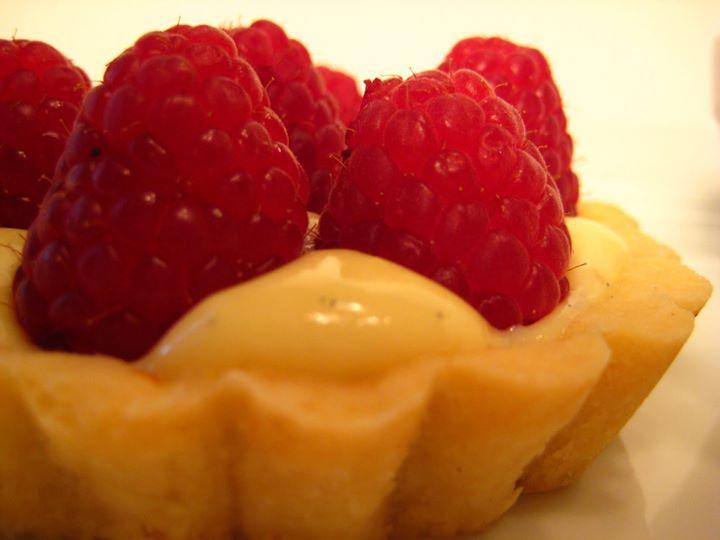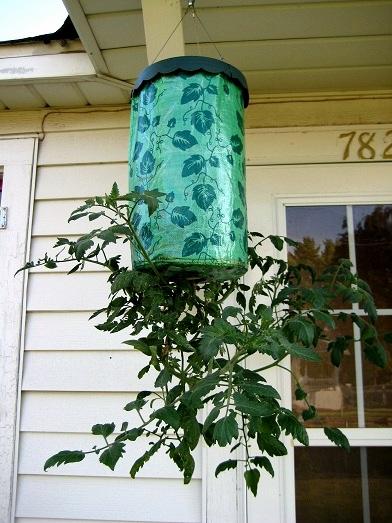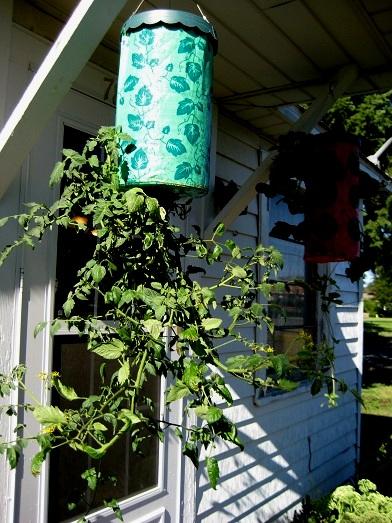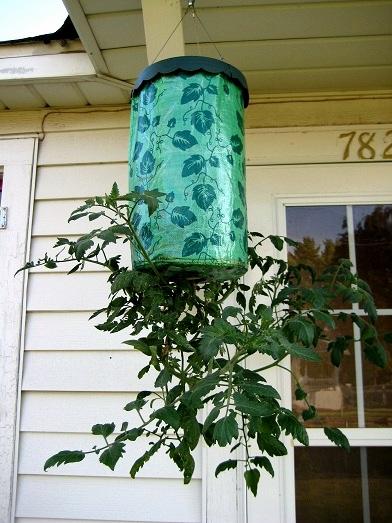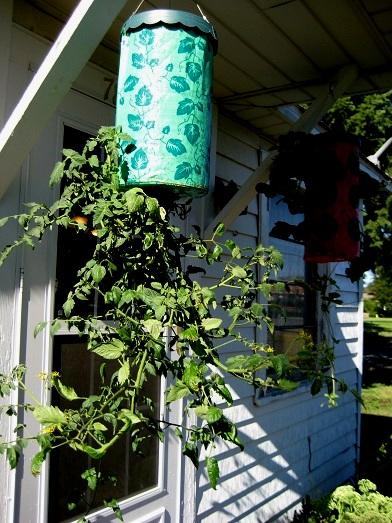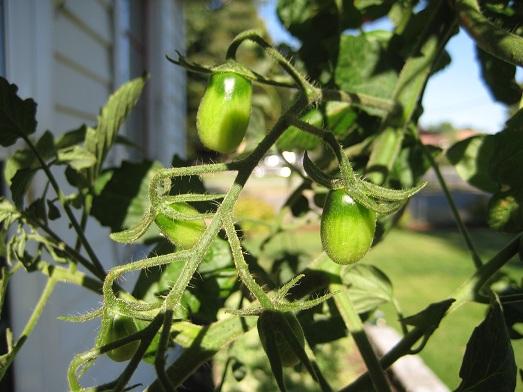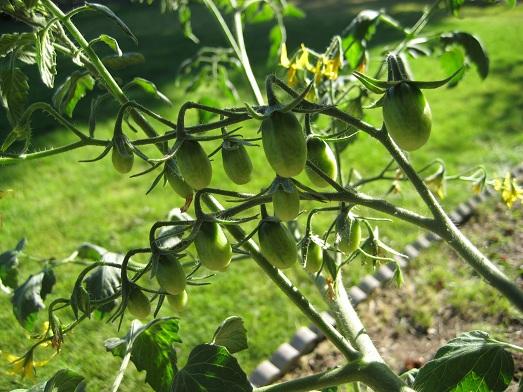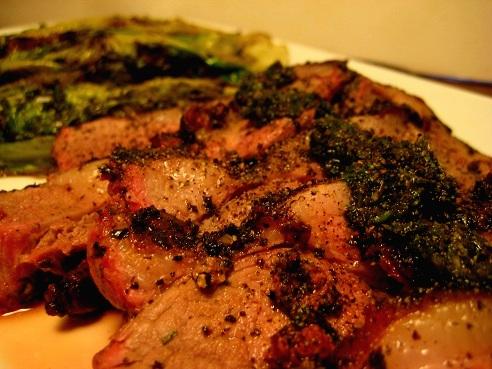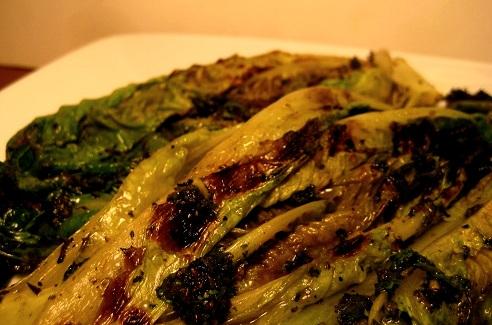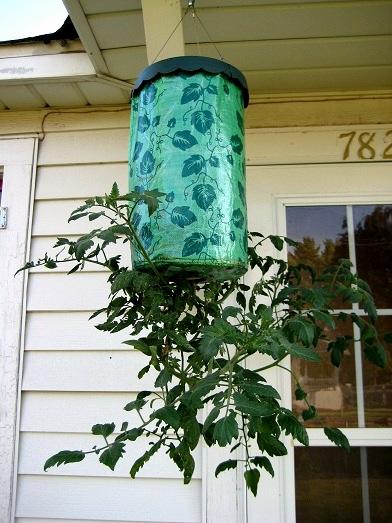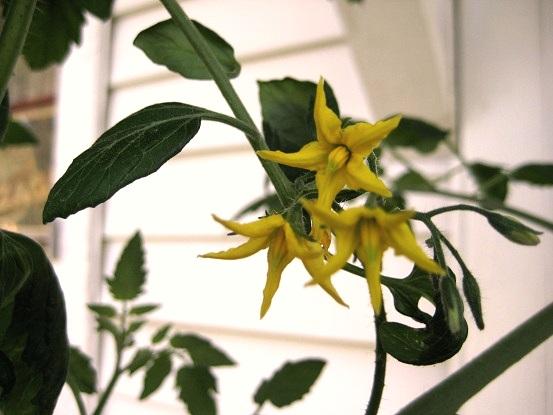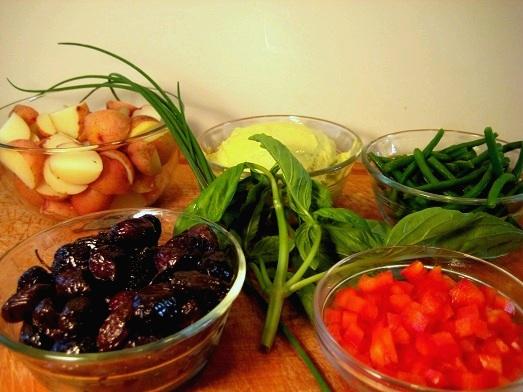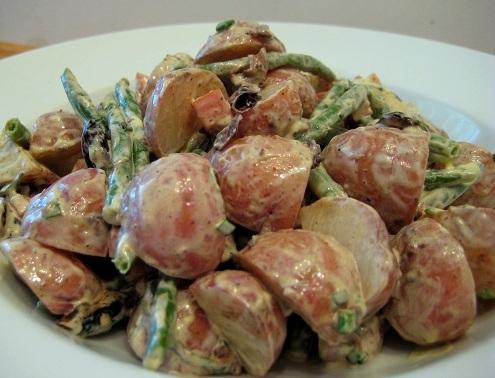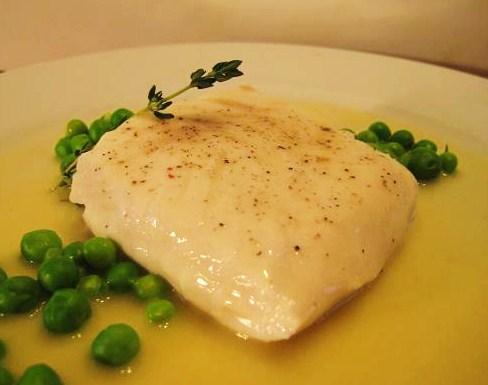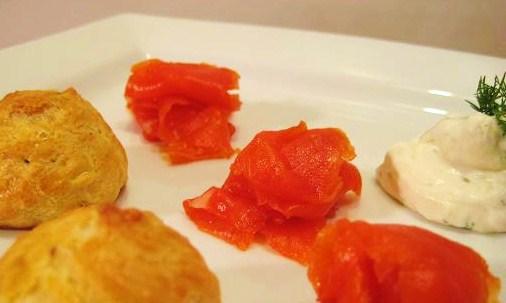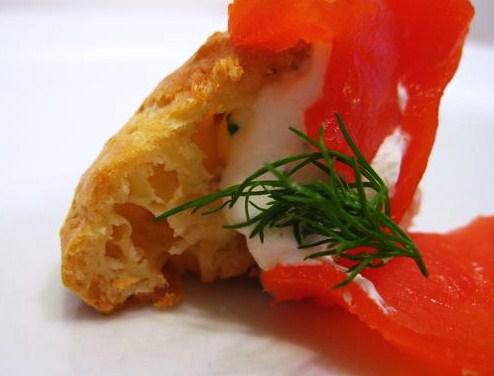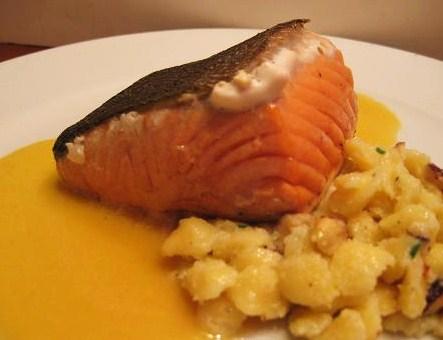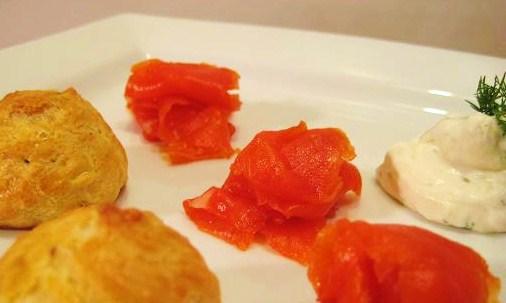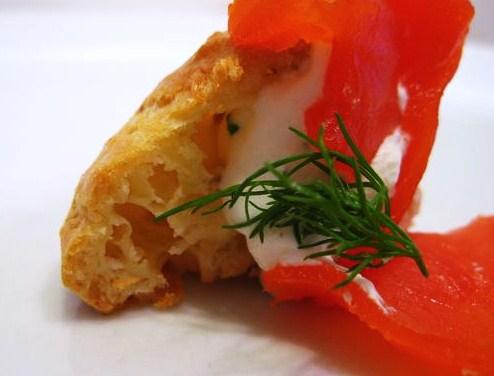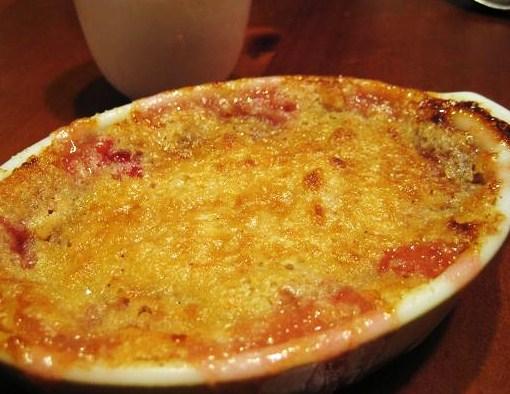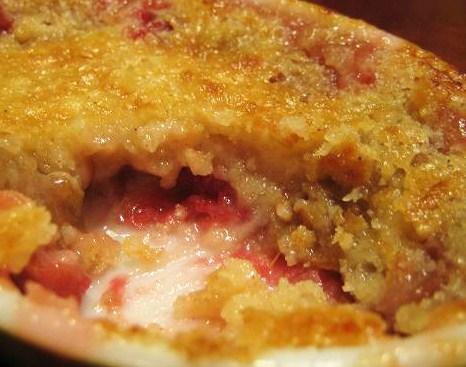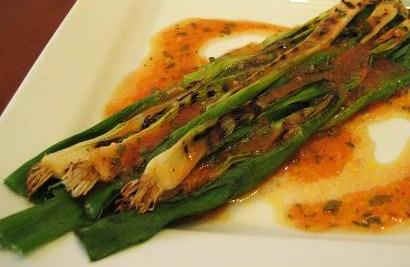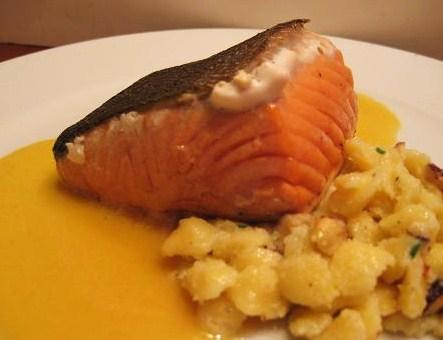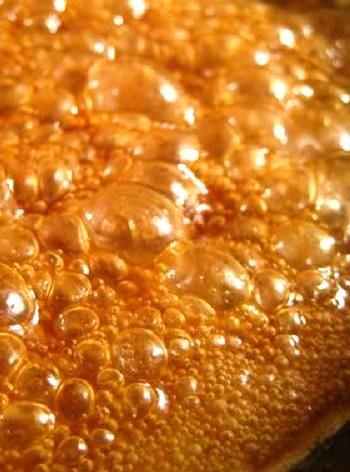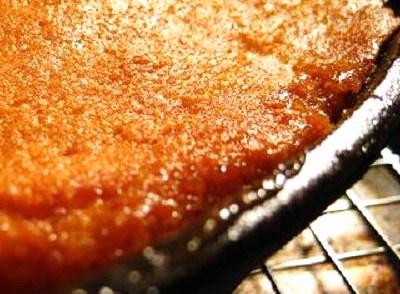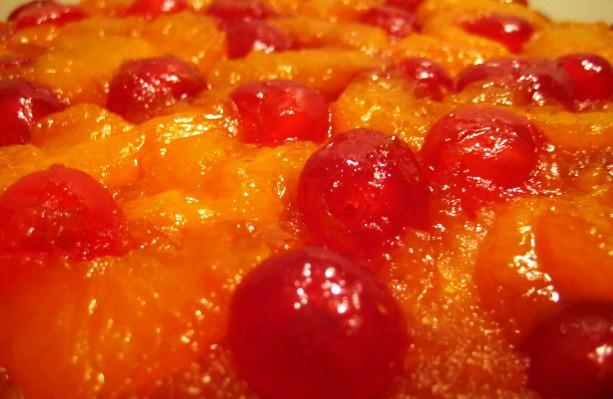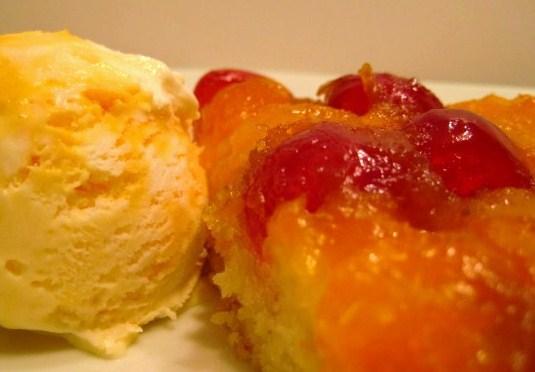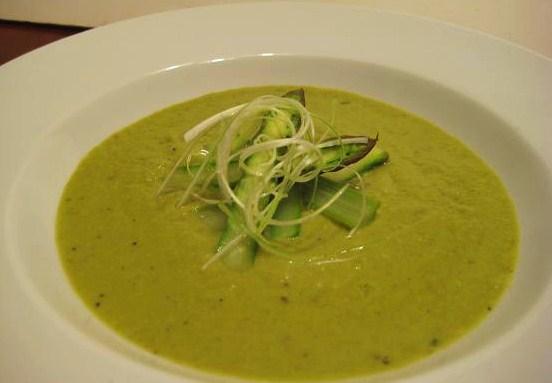-
Posts
5,035 -
Joined
-
Last visited
Content Type
Profiles
Forums
Store
Help Articles
Everything posted by David Ross
-
This past week the weather in Eastern, Washington, has been typically hot for late July--highs in the upper 90's. The tomato plant still is developing a lot of blossoms and in the past week fruit has started to develop. I'm still watering everyday, but I've drawn back a bit on the amount of water. I've read that the inside of the Topsy Turvy planter can get really hot during the heat of summer and if you water too much, the soil gets so hot it can basically cook the roots of the tomato plant so some people recommend drawing back on the water. Another traditional tomato grower I spoke to in Oregon last week recommended pulling back on the amount of water once the fruit started to set because she said that over-watering leads to mushy, tastesless tomatoes. We'll see if she's right when and if we get to do a taste test in a month or so. In the meantime, here's another photo progress report: July 10: July 17: July 25:
-
Just an update on my progress. One week since the last photo and I have considerably more growth and blossoms. No sign of fruit yet, but we've only had about three weeks of hot weather here in Eastern, Washington. The planter soil base was Miracle-Gro and I fertilized it once with a liquid fertilizer and then once today with a granular tomato plant food. Here's hoping that fruit will start to bear soon. July 10: July 17:
-
I'd really like to try the frozen candy bar/twinkie thing. We don't venture that far in Spokane. Maybe this year.
-
Fried foods at State Fairs have become very popular in recent years, moving beyond the days of Elephant Ears, Corn Dogs and huge mounds of twised french fries. Today all manner of sweet and savory, even pickled, foods are deep-fried and served from booths at local and State fairs. Our local fair has plenty of good food to choose from, including bison burgers and wild huckleberry shakes and sundaes. One thing we don't venture into much is a variety of exotic fried delicacies. Fair season is around the corner, so get you stomachs and cameras ready, and show us and tell us what delicious bites you can find at your local fair.
-
I had a taste for grilling some lamb last weekend. I really don't care for those boned, rolled and tied leg of lamb roasts that you find in the supermarkets. I just have some sort of problem dealing with those darn nets the meat is wrapped into and I often find the meat is broken into uneven chunks. I prefer to buy a bone-in leg of lamb and butcher it myself. Takes some work but then I get two roasts-the one I boned and butterflied and grilled on the barbecue, a bone for the stockpot, then a small bone-in leg of lamb I put in the freezer to roast this fall. I marinated the roast in a mixture of mint, cilantro, basil, parsley, garlic, olive oil and pepper. Just before grilling I seasoned the roast with some salt, that's it. I used regular charcoal briquets and grilled the lamb for about 20 minutes per side over indirect heat. To accompany the lamb I simply cut some heads of romaine in half and dipped them in water to rinse off any dirt, then brushed them with olive oil and seasoned with salt and pepper and grilled them for about 5 minutes a side. I served the romaine with some of the same, (yet fresh), marinade used on the lamb.
-
I’ve never considered growing tomatoes. I suppose it’s mainly owing to the fact that I really don’t care that much to eat tomatoes except in pasta sauce. I don’t like raw tomatoes, tomato, basil and mozzarella salad, and I don’t care much for a BLT sandwich. My Father is quite a good gardener, but over the years I’ve watched him struggle with all manner of dusts, sprays and powders to fumigate his tomatoes and fight off crawling, creeping and flying insects. He’s crafted wire barricades and small white picket fences to ward off neighborhood cats and other small creatures, who in spite of his efforts still found ways to burrow under or crawl over his barriers and get to his tomatoes. I’ve watched him launch this never-ending, decades-old war without ever winning. He’s produced hundreds of delicious fruit over the years, but I’ve always thought there had to be a better and cheaper way to grow tomatoes. Then I was watching TV one day….. As a rookie tomato gardener I was looking for the fastest, most economical, maintenance-free method for my first large foray into tomato harvesting. Other than an occasional dose of liquid fertilizer or pre-mixed bug-spray, all I wanted to do was water my tomato plant(s). Nothing else. And given my lack of knowledge into the intricate nuances of the delicate taste variances between the different breeds of tomatoes, I didn’t want to fuss with turning plants at 7am for maximum sun, or setting Italian heirloom tomatoes in Tuscan organic compost or anything complicated like that. Something that “I had seen on TV” would work just fine. I purchased a “Topsy-Turvy Tomato Planter” at my local Home Depot for $9.95. Now if you choose to go the Topsy-Turvy route of cultivation, you are only purchasing the hanging planter device-the nylon hanging planter and the wire hanger and wire hook. You must buy the tomato plants, (2-3 are recommended), the dirt and fertilizer, separately. I purchased 3 tomato plants-1 cherry tomato, 1 yellow tomato and 1 full-size tomato. Unfortunately, I threw out the plastic plant stakes so I can’t report the exact plant breed I purchased. The tough part of the getting started with the Topsy-Turvy is the delicate part of threading your tomato plants through the “bottom” end of the planter. You have to be very gentle and weave the tomato plant through the hole in the end of the planter then secure it with a small sponge. This sponge is what secures the stem of the tomato plant when it hangs upside down. The dirt in the planter, and the weight of that dirt when it gets wet, is what holds the tomato plant “upside-down” and holds it in place-really an ingenious invention. The planter has been up since mid-June and the only task is a daily watering. The planter takes about 1 gallon of water a day. We had record rain in June in Spokane, but the heat came in July and my first blossoms came this week. The plants are growing about 1-2” a day and the stalk is thick and green. Now the tests await. Will the “Topsy-Turvy” produce fruit? Will the weight of the tomatoes pull down the plant and the planter? And the true test. Will the tomatoes taste as good as tomatoes grown the natural way in soil? Do you have a “Topsy-Turvy” tomato planter? Has it worked for you?
-
"Best Happy Hour?" I do get happy about hamburges, fries and soda, but not really at Sonic--and I thought the term "Happy Hour" involved booze?
-
I happen to like the "cottage-cut" fries. Maybe that's just an oddball fry that they do at our local franchise. The limeade is good and so is the cherry cola (and sticky sweet for sure). And of course watching their 2010 version of a car hop on roller skates is pretty entertaining. I have to say they were really fast and really adept on those skates at the Sonic Drive-In I went to--albeit I've only gone twice.
-
Sunny weather has finally decided to come to Eastern, Washington after the third wettest Spring in recorded weather history. And with the arrival of Summer, I thought it might be a good idea to re-generate our discussion of your best Potato Salad recipes. My potato salad starts with homemade mayonnaise. You can find my recipe at the mayonnaise topic here. My potato salad has a Mediterranean accent. I use baby red potatoes, dry-cured Nicoise olives, haricot vert, diced red bell pepper, chives, basil and oregano. I prefer raw red bell pepper because I found roasted red pepper too soft in texture and I didn't like how it turned the color of the mayonnaise red. I toss the potato salad with a good amount of the mayonnaise. This is definately not the traditional mayonnaise and vinegar-based potato salad my Mother made when I was a kid. This potato salad is also good with grilled zuchinni, tuna, grilled chicken and as a side dish for grilled flank steak.
-
My gosh, I would have flown the 3,000 miles just to get BBQ mutton in NYC! Looked pretty good!
-

Eating Oysters at a Fine Dining Establishment
David Ross replied to a topic in Food Traditions & Culture
Chris, I believe what you describe as the other "pointed butter knife" was in fact a fish knife for an additional fish course. Just an assumption on my part, but that is most likely what the knife was for. The tiny two-pronged oyster fork was probably intended to do just what you did--to separate the oyster from the bottom shell. But I would think at Le Bernadin they had already shucked the oyster from both shells and tenderly placed it back into the bottom shell, no? In any case, all manners aside and with consideration for the decorum of the place (and if Chef Ripert had been standing next to me), I would have approached this sweet little creature as I always do--which is to down the poor little devil with one swift, natural movement of my hand. No utensils or silly sauces needed. A simply squeeze of cold lemon juice would have been the only accompaniment needed. I would have done my best to respect the other patrons at the tables nearby, but I can't guarantee that my slurpy pleasure would not have been heard. A temple to seafood should be a temple of pleasure indeed. You are not a rube if you are respectful but still enjoying your oysters. -
I'm still watching and searching for nuggets of shows that I might like and I agree, I also like "Chuck's Day Off." Last week I saw him do a segment with fish that he got from the fishmonger's that supply his restaurant in Toronto. He prepared a couple of dishes and then had them come in and sit down for a meal with him. It was really a quality show-instructive and informative and he's got some class and style in his delivery that I think is attractive to today's audience. Hats off to another quality food show produced and delivered via a Canadian Chef. I've enjoyed some other Canadian cooking shows, (some produced for and aired on Food Network CAN), which in many instances are light years ahead of Food Network US in terms of quality. Hopefully the Cooking Channel will share some more Canadian, (and BBC), cooking programs if they can get their hands on them.
-
Well, I'm agreeing here...and I never checked in with what the Internet told me--I've just always made "salt potatoes" by taking a good Northwest-grown Russet and packing it with a mixture of wet Kosher salt, wrapping it in foil and then baking it in a 375 oven for about 1-1/2 hours or so. Been doing it long before it was probably trendy in restaurants. Gives the potato a soft skin that takes on the salty flavor. Sort of a classier, and tastier, version of that 60's foil-wrapped spud you got in steakhouses of the day.
-
I work with a lady who brings me fresh halibut that she and her husband catch out of the Puget Sound waters around the Seattle area. Last week they caught a 42lb. beauty and brought me some beautiful filets. The cost per pound that I paid...priceless, (no cash was exchanged but as the saying goes, nothing beats fresh fish just off the boat). I used a very traditional and simple recipe from the "Le Bernadin" cookbook written by Chef Eric Ripert and Maguy Le Coze. The recipe was written using "Salmon with Buerre Blanc," but I adapted it for Halibut. It's basically fish poached in a court bouillon and then served with a butter sauce. In the recipe Chef Ripert calls for using red wine vinegar in the court bouillon, but I substituted white wine vinegar because I wanted a milder flavor for the halibut and I didn't want the red wine vinegar coloring the natural beauty of the white flesh of the fish. Other than that, I didn't change a thing to the recipe. This technique is very easy--you simply place the filets in a casserole dish and ladle the stock over the top. Then the fish is poached in a 550 oven for about 12 minutes. It is incredibly moist and tender when it's pulled from the oven. The only garnish was a sprig of thyme to accent some of the flavors of the court bouillon and a few steamed English spring peas. Very simple, easy and delicious.
-
Please do! I liked the idea of adding anchovies to the Gougeres to give them a bit of a salty/fishy taste. I think swiss cheese and marjoram would be a good combination in Gougeres to pair with the gravlax. I've also made the Gougeres with smoked cheddar, but that may be a bit much for the mild flavor of gravlax. But what the heck, you could make four or five varieties and let your guests choose which combination they thought tasted best.
-
This past weekend I crafted some Salmon Gravlax with the last of the Copper River Salmon I'll use for the season. For curing, some of us in the Northwest prefer the Sockeye because it tends to have a thinner filet and more oil in it's flesh than the King which has a much thicker filet and more fat, (which as I mentioned above, I prefer to grill and roast). I bought this Copper River Sockeye at a local large grocery store. The salmon was fresh and sold for $12.99 a pound on a special. No doubt this large retail market had procured a large contract and was able to buy fresh fish on a large scale at this price. But when it was gone it was gone. I was at the market at 7am on Friday morning, June 4 and the fish had just been brought in the night before. It wasn't in the display case yet and at first the guy wasn't going to bring it out when I asked. I think he thought I was probably the typical stupid shopper who wanted the salmon on special. After a few moments of breaking the ice so to speak, he got the vibe I knew what I wanted and that I know my salmon and so he was more than happy to go in the back. I couldn't belive what I saw. Racks of fresh Copper River Salmon. Whole salmon. And really to my amazement they looked and smelled so fresh. What a pleasant surprise for a large, mass-market fish counter. After the sockeye cures, the natural red color of the flesh deepens to a hue that is almost unbelieveable. You almost think it is soaked in fluorescent red paint the color is so intense, yet it is just Mother Nature taking its normal course. I started with Marcus Samuelsson's recipe for Gravlax out of his "Aquavit" cookbook. The basic cure calls for 1 cup of sugar to 1/2 cup of salt. I found this mix far too sweet for my tastes, so I think next time I'll tinker with it a bit and go with a ration closer to 1 cup sugar and 1 scant cup of salt. The recipe called for 2 tbsp. of cracked white peppercorns but I used a mix of white, green, pink and black peppercorns. I also used a blend of both Aquavit and sweet white wine that I had on hand. Some recipes call for brandy, but I like the anise and herbal flavor of Aquavit. I could do without the sweet flavor of the white wine next time. Rather than the normal "bagel," I served the salmon with tiny little "Gougeres" which are basically a savory puff pastry dough. In this version I added chopped anchovy, chives and grated parmesan cheese. I wanted something light to accompany the salmon rather than the typical accompaniments of capers, red onion and cream cheese so I made a whipped cream and added some Dijon mustard, chopped capers, chives, fresh dill, lemon juice and white pepper. It was light and refreshing and the mustard gave the cream a bit of tang yet didn't overpower the salmon. Copper River Sockeye Gravlax, Anchovy-Parmesan "Gougeres," Dijon Whipped Cream-
-
The first Copper River King I bought in Spokane was on May 26. It sold at $28.95 a pound at my old-fashioned butcher shop who also happens to sell some fresh seafood. He sources his Copper River salmon directly from a fisherman and doesn't go through any middelemen or processor's-it goes from the river to the airport in Alaska to Seattle to Spokane and then into the butcher shop. Two other local markets in Spokane were selling the King that week. (I'm old-fashioned and still call it the "Chinook"). One upscale market was pricing it at $34.99 a pound on May 26 and the only fishmonger in town was pricing it as high as $45.00 a pound. That's the highest I have ever seen it, $45.00 is really a bit much. Since I only cook the Copper River King once a year I cook it really, really simple and very delicately--quickly sauteed and then finished with a simple roast in the oven. This year I tried a new technique that I learned about from an article in my local newspaper. It comes from from Jon Rowley, a Seattle-based seafood expert who is noted as one of the leaders in bringing the Copper River Salmon to fame in recent years. Rowley recommends searing the salmon in a hot pan for a minute or two and then turning it and placing it in a low oven, 225-250 degrees, for 10-15 minutes depending on the thickness of the filet. I was skeptical as I didn't think such a "low and slow" roasting technique would work. But it did, and when I tasted it I realized why. The low oven temperature keeps those unique oils of the Copper River salmon from drying out. I seared the fish in a cast iron pan with a bit of olive oil and then put it in the low oven. I actually put the oven at 275 and since this king filet was so thick, it roasted about 18 minutes for a medium-rare finish. I served it with a basic butter sauces with some chipotle chile powder and spaetzle with brown butter and toasted hazelnuts. Nothing for my tastes like fresh Copper River King Salmon.
-
This past weekend I crafted some Salmon Gravlax with the last of the Copper River Salmon I'll use for the season. For curing, some of us in the Northwest prefer the Sockeye because it tends to have a thinner filet and more oil in it's flesh than the King which has a much thicker filet and more fat, (which I prefer to grill and roast). After the sockeye cures, the natural red color of the flesh deepens to a hue that is almost unbelieveable. You almost think it is soaked in fluorescent red paint the color is so intense, yet it is just Mother Nature taking its normal course. I started with Marcus Samuelsson's recipe for Gravlax out of his "Aquavit" cookbook. The basic cure calls for 1 cup of sugar to 1/2 cup of salt. I found this mix far too sweet for my tastes, so I think next time I'll tinker with it a bit and go with a ration closer to 1 cup sugar and 1 scant cup of salt. The recipe called for 2 tbsp. of cracked white peppercorns but I used a mix of white, green, pink and black peppercorns. I also used a blend of both Aquavit and sweet white wine that I had on hand. Some recipes call for brandy, but I like the anise and herbal flavor of Aquavit. I could do without the sweet flavor of the white wine next time. Rather than the normal "bagel," I served the salmon with tiny little "Gougeres" which are basically a savory puff pastry dough. In this version I added chopped anchovy, chives and grated parmesan cheese. I wanted something light to accompany the salmon rather than the typical accompaniments of capers, red onion and cream cheese so I made a whipped cream and added some Dijon mustard, chopped capers, chives, fresh dill, lemon juice and white pepper. It was light and refreshing and the mustard gave the cream a bit of tang yet didn't overpower the salmon. I must say, for a special once-a-year salmon, it turned out quite well-- Copper River Sockeye Gravlax, Anchovy-Parmesan "Gougeres," Dijon Whipped Cream-
-
My version of Rhubarb Crisp. It's actually just my rhubarb pie filling and then the topping is what I use for Italian-style Crostatta's-a mix of sugar, flour and butter on top of free-form tarts. The difference from the Crostatta is that the fruit is baked in the casserole rather than in a pastry and then the topping melts on top. I served it with a Gooseberry Sherbet. Hope to have the photo up tonight. Old-fashioned, somewhat British-inspired and delicious.
-
The only good thing I saw today was Julia preparing salmon gravlax. What a delight to see how she still leads the standard for cooking on television all these decades after those shows debuted on WGBH in Boston. Following Julia was Graham Kerr, aka "The Galloping Gourmet," doing his rendition of Baba au Rhum. I thought he looked pretty silly but I suppose at the time those shows aired and the height of his popularity it was fun for the audience. I didn't get much out of it. Julia clearly shines above all the others. I saw some show the other night but I quickly lost interest and didn't care to go back and even search for the title. It had hope, but the guys presenting the show and the production and writing was so pitiful I left after about 15 minutes. They were making handcrafted sodas. Again a lot of hope--teaching people how to craft sodas at home with contemporary and unique flavors is a topic that I think would be quite popular today. But the way they presented and edited the show was just awful...
-
What a wonderful piece, and I am going to print it and mail a copy via post to my dear 86 year-old Mother, Janet Edna Ross. You see, Mother doesn't have a computer, nor does she know the inner-workings of what we call e-mail. She receives mail via the U.S. Postal service with a first class stamp on it. Mother is not familiar with the term "Bechamel" sauce, but she still makes a wonderful "white sauce" every Christmas for our delicious creamed onions. Every December, Mother pulls out the same hand-written recipe card that her Mother, Edna Pink, used for making the white sauce for the onions. I think Mother knows how to make the white sauce from memory, she's been doing it for probably 65 years or so, but there's something special about seeing and touching Grandmother Edna's recipe written in ink with a fountain pen. It's a Holiday tradition that makes a simple "white sauce" extra special. Now I don't know if Mother's recipe is truly traditional or not as she adds a few sprinkles of nutmeg to her white sauce--I'm not sure what Escoffier would call a sauce with nutmeg. In our home we call it just plain good. Thank you Maggie for evoking a special memory from my Mother's kitchen.
-
Last night started with grilled spring onions with a smoked tomato vinaigrette. I got the vinaigrette recipe out of our local newspaper. It comes from a local restaurant that serves the Vinaigrette with Copper River Salmon, Grilled Cheddar Polenta Cakes and Braised Red Chard. The article caught my eye because we are in the first weeks of the Copper River Salmon season here in the Pacific Northwest. I was interested in reading how our local chefs were going to serve the salmon this year, but I decided that the dish with the polenta, chard and tomato vinaigrette was a bit much for this special salmon. I do love smoked tomatoes, so I chose to serve them as a dressing for simple grilled spring green onions. I use a stove-top smoker to smoke tomatoes and this time I used hickory chips. I smoked the tomatoes for about 15 minutes, then peeled them and addded them to the blender with garlic, salt, lime juice and zest and white wine vinegar. The puree was strained and then I blended that with olive oil, cilantro, basil and chives and stirred in a teaspoon of liquid smoke to boost the flavor. I cut the spring onions lengthwise and then soak them in water so they basically steam and grill at the same time. And the beautiful Copper River King Salmon. The season started this year very early. It showed up in our local markets in Spokane on Friday, May 21. Taking the cue of what I read in the newspaper article, I used a new technique this year for cooking the salmon. It's based on a technique from Jon Rowley, a Seattle-based seafood expert who is noted as one of the leaders in bringing the Copper River Salmon to fame in recent years. Rowley recommends searing the salmon in a hot pan for a minute or two and then turning it and placing it in a low oven, 225-250 degrees, for 10-15 minutes depending on the thickness of the filet. I was skeptical as I didn't think such a "low and slow" roasting technique would work. But it did, and when I tasted it I realized why. The Copper River Kings have so much oil and are so incredibly juicy that you don't want to sear the heck out of the salmon, (and why would you when it costs upwards of $28.00-$48.00 per pound right now?). Searing and roasting at a high temperature can tend to dry out those essential oils, so Mr. Rowley's technique of a quick sear over high heat to seal in the juices and a low heat to roast and finish the fish to medium-rare is a more reliable way to preserve the unique characteristics of the Copper River Salmon. Next week I'm going to do a three-step cooking method of lightly smoking the salmon first, then searing it and then finishing it in the low oven. I wanted to stay true to a Northwest themed dish, but I couldn't find the wild rice in the market that I was looking for so I served the salmon with spaetzle with toasted hazelnuts and brown butter. The sauce was a simple Buerre Blanc with a dash of chipotle chile powder added for a bit of spice.
-
That's a very good question and thank you for pointing it out to me. I make the cake with both types of canned pineapple and I often go back and forth-canned in syrup or canned in natural juice-so that's why I get lax in interchanging the words in the recipe. Thanks for the reminder of an important detail. Of course, it's a matter of taste. I agree with you on the point of using pineapple canned in syrup, it's very sweet. A 20 ounce can of pineapple slices canned in 100% pineapple juice with no sugar added has 14 grams of sugars. The same size can of pineapple slices in heavy syrup with added sugar, has 22 grams of sugars. The cake in the photo above was made with pineapple slices in heavy syrup. If we did a side-by-side photo comparison of two cakes-one made with pineapple in juice and one made with pineapple in syrup-we'd probably not see as much sticky caramel bubbling around the edges of the cake and out the sides of the cast iron skillet than we would with the juice version. The caramel from pineapple canned in juice is going to be more "runny." Using pineapple in juice won't make a sticky, caramel that seeps down into the cake, leaving the cake a bit more dry than the syrup version. And finally, if I use pineapple canned in natural juice it won't have as much of that gooey caramel clinging to the Maraschino cherries on top of the finished cake. I guess for me in the end if I had to make a choice I'd go with pineapple canned in syrup. Mind you, I only make this cake maybe two, three times a year. It's very, very sweet, but oh so worth it to taste something so wonderful if only a few times a year.
-
I wanted to share my recipe for Pineapple Upside-Down Cake. While I don't use the prize-winning recipe from Mr. Dole's canned pineapple contest, I use a "retro" recipe from a time-tested, classic cookbook-the 1968 edition of the Better Homes and Gardens "New Cookbook." The byline inside the red and white checked front cover of the cookbook reads "The New Cookbook has sold 13 1/2 million copies-America's favorite by far." Fourty-two years later no doubt millions more American home cooks have discovered the delicious results of the recipes within the metal rings and tabs of this beloved cookbook. Section four is where the "Cakes, Frostings, and Fillings" reside in the "New Cookbook." Behind the yellow tab, residing on page 70, you will find recipes for Applesauce cake, White Cake Supreme, the regal Lady Baltimore cake and a favorite of farm families, the Buttermilk Cake. Yet the prime space on the page, the upper-left corner, is reserved for the Pineapple Upside-Down Cake Recipe. Of course, one must carry on the tradition of Mr. Dole's legacy by starting with a can of Dole pineapple slices. In terms of a cooking vessel, I use a cast iron skillet. Cast iron is perfect for any type of cake where you are making a caramel-be it a Pineapple Upside-Down Cake or an Apple Tarte Tatin-it retains heat consistently without letting the caramel burn. And, even more importantly, a well-seasoned veteran cast iron skillet is naturally "non-stick." In other words, you don't need to buy an expensive, high-tech, non-stick pan that may not endure the rigors of your kitchen. A cast iron pan is reasonably cheap, hearty, heavy and will last a lifetime. Now I do make a few slight variations from the printed recipe. I double the amount of caramel, (the syrup on the "bottom" of the cake), yet I keep the amount of "cake" batter true to the recipe. This way I have a greater ratio of "sticky" caramel and pineapple on the "bottom" to the amount of "cake" on top. At least that's what we start with. The Caramel, pineapple and cherries- 1 20oz. can sliced pineapple, save the juice (you will have some juice and pineapple leftover) 6 tablespoons butter 1 cup dark brown sugar Maraschino cherries Heat the oven to 350. Heat a 9" cast iron skillet over medium-high heat. Add the butter and melt. Add the brown sugar and 1/4 cup of the reserved pineapple juice. Stir until the brown sugar melts and begins to gently bubble. Cook for about 8 minutes, then add the pineapple slices, covering the bottom of the skillet in one layer. Stud the center of the rings of pineapple with Maraschino cherries. Note: this is a matter of taste, I happen to love lots of cherries, so I stud each ring of pineapple with two cherries and place cherries in the spaces around the pineapples slices. Turn off the heat and as you prepare the cake batter. The Caramel- The Cake- Reserved canned pineapple syrup to make 1/2 cup 1/3 cup Crisco shortening 1/2 cup granulated sugar 1 egg 1 tsp. vanilla 1 cup all-purpose flour 1 1/4 tsp. baking powder 1/4 tsp. salt Cream together the shortening and sugar. Add the egg and vanilla. Sift together the flour, baking salt and then add to the creamed mixture. Add the reserved canned pineapple syrup. Note: If there was note enough leftover pineapple syrup from the can, add water to make 1/2 cup). Spoon the batter over the top of the pineapple slices in the cast iron pan. Smooth the batter so that it seals over the top of the pineapple. Bake in the 350 oven for about 35 minutes or until a toothpick inserted into the cake comes out clean. The Cake- Remove the skillet from the oven and let it cook about 8-10 minutes on a wire rack. Don't let the cake cool too much or the caramel will start to set and it won't easily release from the skillet when you turn it "upside-down." Place another rack over the top of the "cake," then gently invert the skillet, turning the cake "upside-down." The cake should gently release onto the rack, revealing the "top" of pineapple slices, caramel and cherries. "Upside-Down"- Pineapple Upside-Down Cake with Vanilla Ice Cream-
-
The fresh asparagus in Eastern, Washington keeps coming. I've never seen a season like this-week after week after week of fresh asparagus. Thank you Mother Nature. This past winter I sure didn't miss the 4' of snow we had in the winter of '09, and I sure like the spring crop of asparagus in '10. The price is now down to 99 cents per pound. Last night I did a simple Cream of Asparagus Soup. The garnish is Steamed Asparagus Spears and a few threads of Spring Onion-

